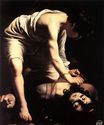Caravaggio - The Fortune Teller 1595
 |
 |
 |
 |
 |
 |
 |

The Fortune Teller 1595
99x131cm oil/canvas
Louvre, Paris, France, Capitoline Museums, Rome, Italy
The image is only being used for informational and educational purposes
<< Previous G a l l e r y Next >>
From Wikipedia, the free encyclopedia:
The 1594 Fortune Teller aroused considerable interest among younger artists and the more avant garde collectors of Rome, but, according to Mancini, Caravaggio's poverty forced him to sell it for the low sum of eight scudi. It entered the collection of a wealthy banker and connoisseur, the Marchese Vincente Giustiniani, who became an important patron of the artist. Giustiniani's friend, Cardinal Francesco Maria Del Monte, purchased the companion piece, Cardsharps, in 1595, and at some point in that year Caravaggio entered the Cardinal's household.
For Del Monte, Caravaggio painted a second version of The Fortune Teller, copied from the Giustiniani but with certain changes. The undifferentiated background of the 1594 version becomes a real wall broken by the shadows of a half-drawn curtain and a window sash, and the figures more completely fill the space and defining it in three dimensions. The light is more radiant, and the cloth of the boy's doublet and the girl's sleeves more finely textured. The dupe becomes more childlike and more innocently vulnerable, the girl less wary-looking, leaning in towards him, more in command of the situation.